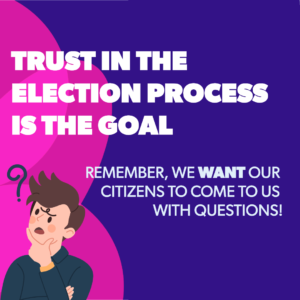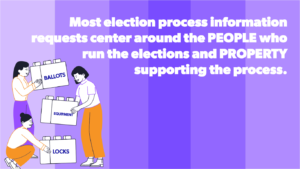TRUST in the election process is the goal. It’s paramount for public servants to gain and retain the constituents’ trust. The public wants assurances that the election process is transparent and non-partisan. This trusted relationship is enhanced with a quick and reliable response to constituents requests for election information.
 Remember, we WANT our citizens to come to us with questions! The Elections Office is the source of information regarding the election process. Providing easy access to the elections process and information with full transparency and visibility is a great first step. A trustworthy environment is better if the process of citizens asking questions and getting answers is simple, safe and secure.
Remember, we WANT our citizens to come to us with questions! The Elections Office is the source of information regarding the election process. Providing easy access to the elections process and information with full transparency and visibility is a great first step. A trustworthy environment is better if the process of citizens asking questions and getting answers is simple, safe and secure.
As it’s reasonable to expect information requests, it seems wise to prepare. When it comes to the election process, there are two main areas of information requests.
1. The information itself. There are predictable data points which will be requested. With a logged history of requests, it’s easier to prepare for future requests.

2. Processing the requests. Having an easy-to-use and clearly auditable Project Management System in place is an industry “best practice”. Relying on shared spreadsheets and homemade tracking solutions may not be effective.
Most election process information requests center around the PEOPLE who run the elections and PROPERTY supporting the process.
- Questions about PEOPLE include: How have election workers been trained, prepared and scheduled? Are election officials following well-established procedures?
- PROPERTY questions include the machines used and election sites. Are the election equipment safe and used appropriately? Are the election locations safe and secure?
These questions address WHO, WHAT, WHEN, WHERE and HOW. As the two pillars of PEOPLE and PROPERTY often overlap & interact, it’s important to have a system which has the entire election ecocyle information stored in one, interactive environment. This allows for accurate data storage and reporting. Data from multiple and various systems may provide inconsistent results. A single environment allows for changes in one area to be carried over to other areas within the entire system. This provides efficiencies and accuracy, building TRUST.